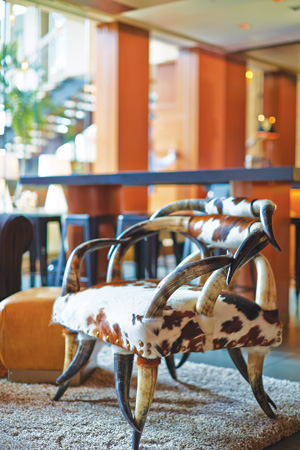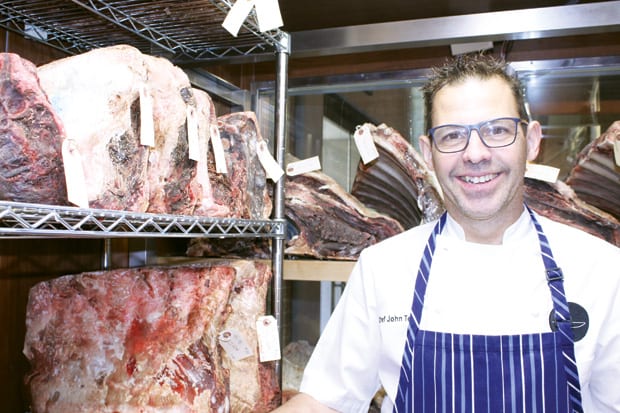The recent kerfuffle between volatile chef John Tesar and a food critic played out like a movie plot, drawing national attention to Dallas’ foodie scene. We go inside the controversy and examine how a local steakhouse is redefining a lot more than just social media, it’s also reinventing a sacrosanct Texas institution

THE HURT LOCKER | There’s more than $30,000 worth of meat inside Knife’s meat cooler, where careful control of temperature and humidity preserve and cure exquisite cuts. (Arnold Wayne Jones/Dallas Voice)
ARNOLD WAYNE JONES | Executive Editor
The timing could not be more propitious. It’s the night after Leslie Brenner, the divisive food critic for Dallas’ only daily, has published her review of Knife, and the chef-owner, John Tesar, is still fuming. He might not put it that way, but the twitterverse seemed to disagree. In what seemed like a scene from the recent movie Chef, wherein a volatile golden-boy cook inadvertently tweets angry messages to a food blogger, unaware that his crimson-laced missives were public, Tesar started a Twitter war over Brenner’s damning-with-faint-praise write-up, a three-star review that reads more like a hatchet job.
At least, that’s how Tesar sees it.
The irony is, the Chef plot couldn’t be further from the reality. For one, unlike the movie character, nobody behind a stove understands the power of social media better than Tesar. He knew exactly what he was doing, which is why, less than 24 hours after the foodie scene in Dallas — and eventually, across the U.S. — exploded in camps of support for one side or the other, he has no compunction talking about it frankly in front of a journalist with a notepad.
“We’re banning her from our restaurants,” he declares with I-don’t-care-who-hears-me defiance. “Why should we let her in? Would you invite someone who opposed gay marriage into your house?” he asks rhetorically, to nobody in particular, as if the two were the same.
The other ironic truth of the movie comparisons were, they kind of went past Tesar himself.
“The funny thing is, people thought I was trying to imitate what happened in Chef,” he says, “but I haven’t even seen the movie!”
Not that he cares. The controversy, if nothing else, just increased the Hot New Thing talk that had made Knife — at the former Hotel Palomar (now The Highland) in the restaurant space that was known as Central 214 — the sizzling new restaurant in Dallas this summer. “It’s kind of nice to wake every morning and tweet back-and-forth with [New York Times food critic] Pete Wells and [Pulitzer Prize-winning Los Angeles Times food critic] Jonathan Gold,” Tesar grins.
Still, it’s not about a difference of opinion, the chef insists, it’s about a personal vendetta — a confrontation between critic and chef, between writer and creator. As much as he protests, despite any of the positives, he’s angry. But the dispute is not, ultimately, where his passion lies. It’s with food and serving his customers a meal to be proud of.

TEXAS STYLE | Tesar knew that if he was going to do a steakhouse, he’d have to push boundaries in style and substance. Otherwise, ‘the critics would come after me.’ One did anyway.
“The real reason I got mad at Leslie — which is something no one has asked me — was very specific,” Tesar tells me. “I grew up in New York City, where the star system had meaning. You needed to have sommelier crystal and a certain level of service to get [the highest marks]. There was a map as to what it took to get a certain amount of stars. She’s undermined that in Dallas. She’s trying to better her brand at the expense of mine.”
Tesar speaks in measured but lively tones, not frothing or bitter but as someone who truly lives for the give-and-take between kitchen and dining room, between artist and patron.
“A restaurant without a restaurant critic would be like an unregulated industry,” he readily offers. “We need constructive criticism. I think I take constructive criticism well. Leslie does not take criticism at all. Anyway, the hotel is filled with energy. It’s because of my success that I can tell Leslie Brenner to go fuck herself.” (He later apologized for his choice of words.)
This is the kind of free publicity that most restaurants can only dream of. A brand-name celebrichef — volatile and well-known, he was even on a season of Top Chef — who was once called the most hated cook in Dallas seems to generate curiosity and foot-traffic. And all for that most commonplace of Dallas institutions: a steakhouse.
All he has to do is keep them coming. And he thinks he’s found the way to do that.
John Tesar walks into a room the size of an average closet he keeps under lock and key. Every square inch is lined with tens of thousands of dollars worth of goods. Only it’s not furs or diamonds or Faberge eggs he’s securing, but meat — some blood red, some the color of heirloom tomatoes. The best ones, surprisingly, have a touch of white mold growing on the outside. Tesar’s eye sparkles when he notices a new patch. He rubs it over the flesh. “That’s what cures and flavors the meat,” he explains. “The secret was 30-degree meat locker with 40 percent humidity to allow the white mold to grow while preventing any black-spore mold from growing on it.” Some of the cuts will age more than half a year before reaching the level where Tesar feels comfortable serving them to his patrons.
It takes a special kind of personality to open a business in May, knowing full well that the signature item won’t even be available until October. Say what you want about Tesar’s persona — he is chock full of patience.
“When it comes to meat, the real work isn’t on the stove, it’s in that room,” he says. Tesar ages and nurtures each slab like a brood-hen, turning out a finely marbled product worthy of the $80/inch (you heard me) he will eventually charge for the best cut. The elegantly prosaic preparation will finish it off: a salt rub, a little bit of pepper, some olive oil and an incredibly hot oven burning red oak. “It doesn’t take a lot of fuss to turn a piece of meat into an experience,” he says. (See review, Page 18.)
Tesar was first approached by the hotel (Kimpton at the time) about developing a concept after chef Blythe Beck left. Before they could feel out a plan, chef Graham Dodds came onboard and Tesar’s involvement went into stasis. “After that ran its course, Michael Hanlon and Jeff Burns reconnected with me,” he says. What would the style be? It was Burns who first said, “I like steakhouses.”
Tesar was dubious.
“I knew that I couldn’t just do a steakhouse in Dallas. I told them the critics would come after me for that — doing steak in Dallas? Most steakhouses have an executive chef on duty, but they are like factories — they just turn it out. I said, what if we did a steakhouse like a real restaurant, fine-dining like a French place or what we do at Spoon? So I said, ‘I have to do it differently if I do that. If there’s criticism, I’ll take the knocks for it.’”
After the decision was made, a million bucks went into the renovation. But that was just the start. The process was complicated; he first had to figure out the limits of what a steakhouse could do. Pappas Bros. Steakhouse — which Tesar openly admits is the finest steakhouse in Dallas already — ages most of their meats 40 to 45 days. But he’d heard rumor the place in Las Vegas had extended the dry-ageing process to 240 days — basically three quarters of a year. I tell Tesar I didn’t know that was even possible. “Neither did I until I met them,” he replies.
“It was this place serving alternative cuts,” he says. “But it was Vegas, where people are on expense accounts and just trying to impress people. They are sometimes not able to appreciate what they have in front of them — they are the kind who might order a steak with ketchup and miss the whole point. Texas isn’t like that.”
But Tesar isn’t a head-in-the-clouds concept artist. He gets the practicalities of running a restaurant that serves the most number of people. While splurging can be a special treat, he wants a communal place — high-end but accessible, where heiress and hipster dine elbow-to-elbow.
“When you decide to go to a steakhouse, you’ve defined your experience before you’ve even walked out the door. I just wanted to see how I could do steakhouse better,” he says.
“We’re in between Lakewood and Highland Park,” Tesar says with a pause, letting that factoid sink in. Plus it’s located inside a hotel, with out-of-towners being catered to as well. He wants a diverse crowd of all kinds who can enjoy everything his techniques have to offer.
“Occasion restaurants are great, but if that’s all you’re serving to — the guy who comes in for $300 meal — that’s not going to get you as much repeat business,” he says. “My benefactors had a vision and I had to insert all the pegs in the right holes: modern, affordable, high-end,” he says.
He found a supplier in 44 Farms, as well as meat mainstay Niman Ranch and many other boutique ranches to flesh out the contours of the menu. “We have a $12 burger and a $25 steak. We’ll have a projector outdoors soon for movie nights and gorgeous projected images with the DJ out there [on other nights].
Brunch and lunch will open right after Labor Day. It’s going to be a nice brunch.”
Brunch, of course, might as well be code for “gays,” and Tesar is good with that. He actively courts the imprimatur of gay approval from the social denizens who stretch morning mimosas into its hip, crepuscular cocktail culture. Tesar is from an old-school Kennedy Democrat New York family, so progressive causes are close to his heart. For six years, he’s been the driving force behind that AIDS fundraiser Burgers and Burgundy, which takes place every fall. (This year will be at a private house on Oct. 3.)
“I was asked to be on [DIFFA’s] Style Council, and I agreed to do it before I realized I was going to have to raise money. I thought, what am I going to do to do that? I could have asked customers, but I didn’t want to do that. So I decided instead I would just raise the money” with the cookout. It was such a hit, it’s continued on.
AIDS is a topic he feels about almost as passionately as his food. “I grew up working at a French restaurant where I was the only straight man in the kitchen,” he says. “I was living in New York in the ‘80s and I lost a lot of friends,” so when it came to picking a charity to sponsor, “I said, I’m not changing causes in midstream.”
Which, curiously, brings us full-circle. Tesar almost doesn’t get all the fuss, though he doesn’t exactly discourage it. “We’re not reinventing the wheel, we’re just cooking steak,” he says about the reaction by so many over the review. But here’s something to keep in mind: Just this week, the studio that made Chef announced it will be re-releasing the film into theaters again next Friday. Just a coincidence?
Maybe. Then again, John Tesar knows as well as anyone that sometimes Knife imitates art … and sometimes vice versa.
This article appeared in the Dallas Voice print edition August 22, 2014.


